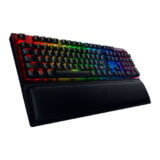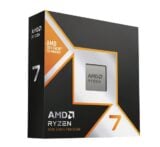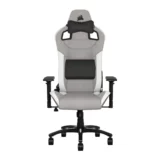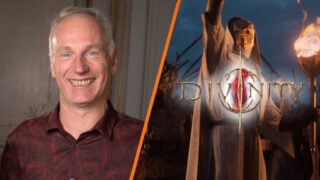Interview: Why does Smite need a sequel?
Smite 2 developers talk monetisation, the launch roster and more

Smite 2 was officially confirmed during the Smite World Championship from Arlington, Texas in front of a packed Texas esports arena.
The event, which saw the Jade Dragons take home Thor’s Hammer in a tense final battle, also saw the first details revealed about the sequel to the preeminent console MOBA.
While excitement in the room was palpable during the announcement, it was followed by some hesitation. Why were they putting a ‘2’ on the end of it? Why isn’t it just a new season of content? Does Titan Forge know how difficult it is to make a successful live-service sequel?
We sat down with three of the people charged with pulling that off – Travis Brown, the general manager of Titan Forge and creative director on Smite 2; Alex Cantatore, the executive producer of Smite and Smite 2; and Daniel ‘PonPon’ Cooper, an advanced game designer on Smite 2.
So, why is it Smite ‘2’?
Travis Brown: When we were working for the last several years, we dabbled on other Smite IP projects, we’d take a small team and make a new game mode or something else small. But then when we got our hands on UE5 in December of 2022, we found that it was incredibly quick to make games. We managed to prototype a new game mode in four weeks.
That wasn’t quite what we were looking for, so we used it for another game mode after we had some experience and that took one day. We were like “woah, this is super powerful.” Eventually, we thought, what if we just make Smite in UE5? So we took around five people out of the office and about four weeks later we had a playable version of Smite in the engine.
After that we decided to go full force and create an amazing new Smite experience and give the players what they’ve been begging for – visual upgrades, more stability, and so on. After that, we decided to go all in on Smite 2.
Alex Cantatore: That revelation kind of came at the perfect time because we were just hitting roadblock after roadblock when we wanted to do even some small things. We worked on HUD redesign for 18 months and we ended up not using it. The developers did great work but we were held back by Flash, which is only capable of running so much.
We added all of these extra stats to the game’s UI and it was slowing the whole game down because of Flash and we got to the point where we said “oh God, this is a mess.” So to do a new UI in the existing tools it was going to take something like three years, so we thought: “Is this the best path forward for the game we love? Is this going to get us another 10 years of Smite?”

In the past decade, which has seen the explosion of the live service genre which has come to dominate much of gaming, many companies have struggled to transition even the most invested of player bases over to a fully-fledged sequel.
Daniel “PonPon” Cooper: We were just really excited to see what the engine could do and see where we could take our characters. I came from the community – when I first installed it I didn’t play any other game for a year – so now I’m elevating these characters that we’ve all come to love.
We were also conscious that we’ve done 10 years of refining, and we’ve kept an audience for 10 years in the live service space, but there have been things we’ve found that we want to change and make the game more approachable, while also adding depth, so we see that as a win-win.
There have also been changes that seem small but in the context of the game are huge. With Ymir, when we showed people in the office his wall launch ability everyone went “whoa,” and everyone was super amped. We have an amazing opportunity with our characters to preserve what made them special, but then add small elements to really elevate them.
Smite 2 will launch with a roster of around 25 Gods, a far cry from the 130 that currently make up the cast of Smite. What was it like going back to such a comparatively limited roster?
AC: I think it’s been fun to go back to a smaller roster. It gives me nostalgic vibes from the early days, I think it’s because I’ve been playing for so long. There are obviously players who are very attached to some Gods, and they say things like, “Oh, I’m not moving over to 2 until there’s this God,” and I think that’s why we’re rolling out Smite 2 more slowly. We want to make sure players have the time to wait for the characters they want, and so they don’t feel like they’re forced over to Smite 2 before it’s out fully.
TB: I love that when we’re re-evaluating all these Gods, we’re talking about Gods that we haven’t played in years, and now we’re playtesting them daily. If we did that with the original roster, it would take us four months to playtest all of them. We’re not looking to turn every God on their head and give them a whole new skill set. We’re more looking at why you play a certain God and how to improve that.
DC: We have our own little internal meta of what’s really good, and the second you add one more character to that, you start to see things open up like different team compositions, and it helps remind us what niche these characters really fit in.
AC: It also helps us focus on core gameplay because it’s very easy to spend a lot of time on balance and changing ability, but at this part of development, nailing this core gameplay is where our focus needs to be.

You spend a great deal of time working alongside your most hardcore players and getting feedback directly from them. How do you balance feedback that is applicable to a pro player and something that will actually improve the game for the general audience?
DC: We have our community council, and we also have Discord with our pro players, and when they come to us with a problem, it’s not about instantly fixing it or reacting to it. It’s about talking to them and them saying, “oh this doesn’t feel right, this feels too casual for XYZ reason.” We take that feedback, talk through it with them and see where the problem lies, versus just taking every complaint as the same and immediately forcing out a solution for it.
It also helps that they are our most forward-facing players, so when it comes to explaining a change, most players don’t read patch notes, most don’t watch developer diaries, but our community has some really popular content creators, so to have them explain and give more context for a decision means the community has all the information they need regardless of where they get it.
“I think it’s been fun to go back to a smaller roster. It gives me nostalgic vibes from the early days, I think it’s because I’ve been playing for so long.”
TB: We’re looking to recapture some of the players who’ve played Smite over its lifetime, and we want them to have the opportunity not to be overwhelmed by a bunch of hardcore decisions that we or the pro players made.
In fact, over this weekend at the Smite World Championships, I’ve been watching pro players and taking one or two notes, but it’s when watching completely new players that my phone totally fills up with feedback, so we’re very dedicated to making it easier for new players to get involved.
During the reveal of Smite 2 you also outlined how players who’ve spent money in the first game will be rewarded, with a Legacy Gems system which will see players being able to use Smite 1 Gems to partially pay for Smite 2 content. Were you at all nervous about announcing the Legacy Gems scheme and what has the feedback been like from players?
AC: I think we were. You’re always a little nervous when you say anything, so I think we were definitely a little bit worried. We felt good about our strategy, we developed it alongside our community. When we started working on Smite 2 and we said it was going to be a full sequel, it became clear that we had to come up with a way to do this, since something like just transferring all the content wasn’t going to be feasible.
We spent a lot of time thinking about it and we went to the community and asked them what they wanted, we went back to them with a plan and they said “It’s ok,” (laughs). So we went back and thought about what players want – they wanted their gems, they wanted recognition for their decade in the game.
So we developed this current plan and went to the community council and they said: “Wow, you guys are being more generous than we thought you would be.” So that’s when we thought we’d found a solution that works.

Smite is unique in the sense that it’s a MOBA that is heavily console-focused as well as PC. What is that playerbase split like and how is that impacting your plans for Smite 2?
AC: About two-thirds of our players are on console, so it’s a very important audience for us. I think that’s really because this person’s combat generally feels really good on a controller. We’ve been talking to players this week and they’re saying “Man, this feels better on a controller,” so it’s a huge focus.
Most of the dev team plays on console because we want to make sure that the experience is great. It’s very core to our design philosophy, the way we design core systems, the way we design Gods, the way we design abilities.
The Smite World Championship has been one of the largest in-person esports events since the pandemic. What kind of feedback were you getting from the community in advance of bringing the in-person events back, and what are your plans for the future?
AC: The Smite community is very tight-knit. As much as they love this event for the esports, it’s also about sitting in the stands watching it together, or seeing people you haven’t seen in years at the hotel. Those are all magical moments for me.
Post-pandemic it was all about finding the right venue to scale up for our ambition, so that’s why we picked the esports facility here in Arlington, Texas. We feel like our European and UK community has been a little ignored since the pandemic so we’re looking forward to going back there.















